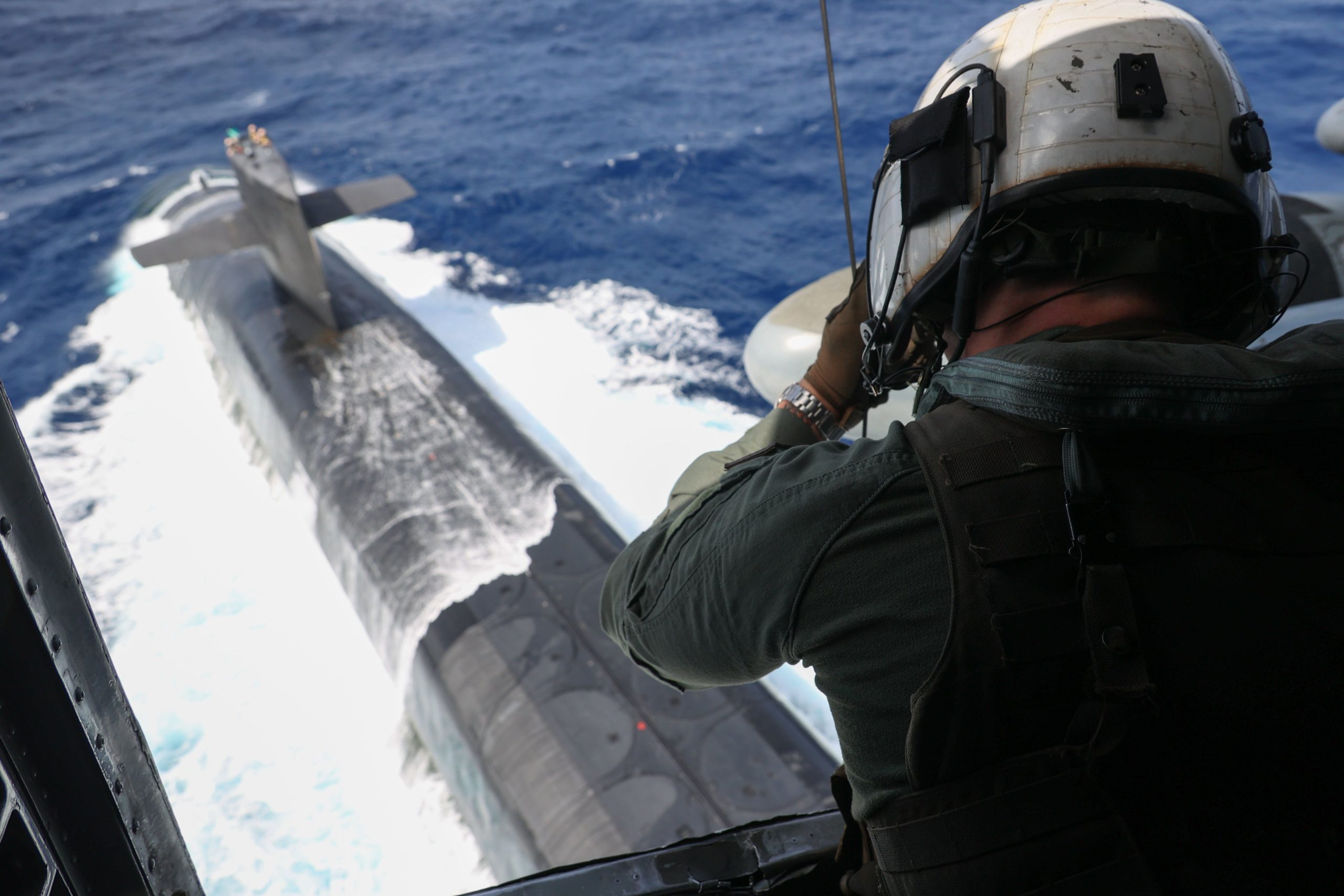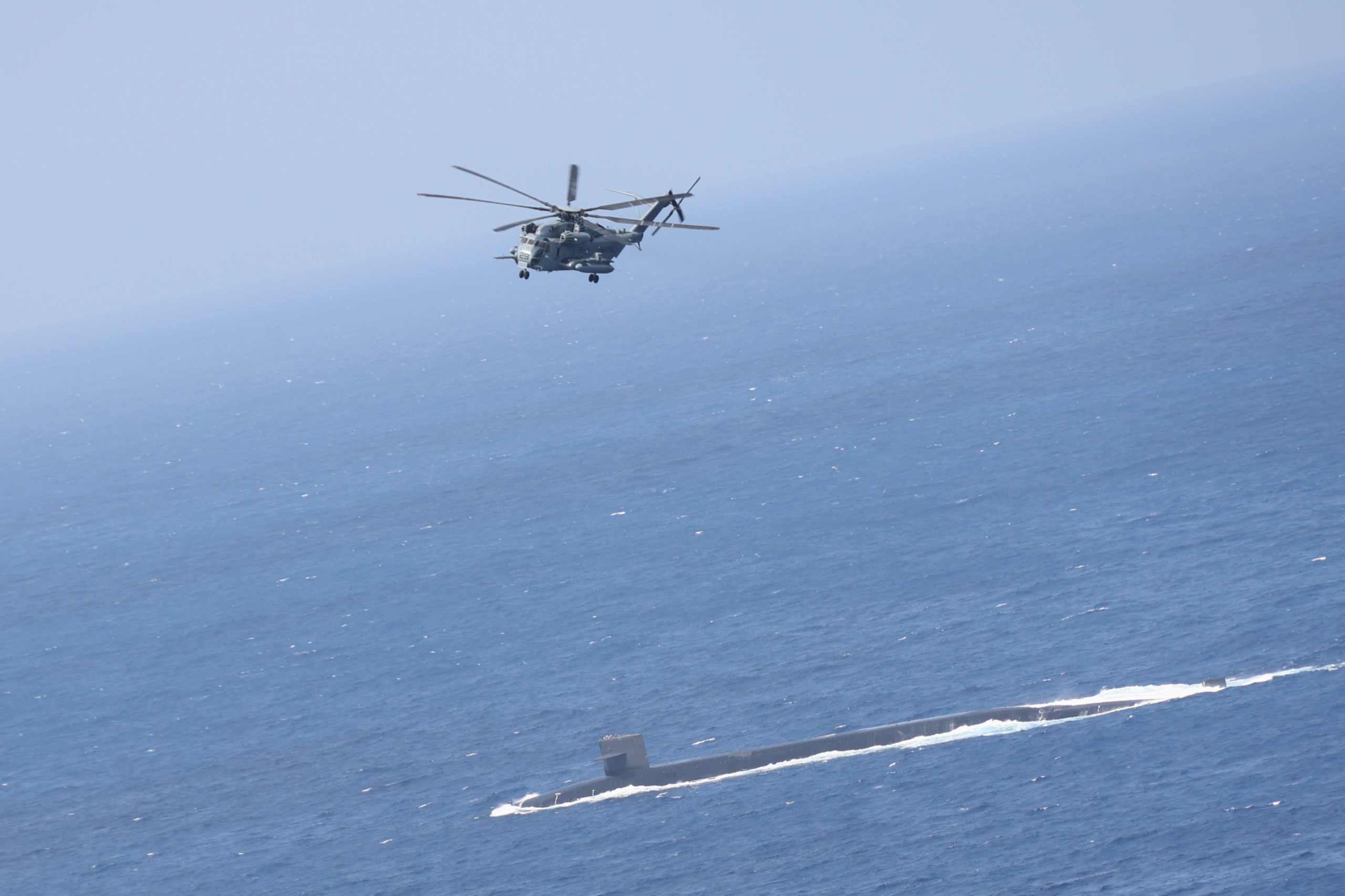The US Marine Corps (USMC) Expeditionary Advanced Base Operations (EABO) evolved to another level when two heavy-lift CH-53E helicopters replenished the USS Ohio ballistic missile submarine in the Philippine Sea earlier this month.
It also marks the US Navy’s submarine fleet shedding the secrecy of its vessels’ deployments by publicizing their presence at key flashpoints, clearly departing from its “silent service” motto.
The EurAsian Times had recently reported vertical take-off and landing (VTOL) F-35B stealth fighters being experimented with for operating from crude landing zones (imitating small islands belonging to the Philippines and Japan) while being rapidly refueled and armed by aircraft like the V-22 Osprey.
Called Obsidian Iceberg, the goal was to try and work out the logistical and tactical chinks of operating in China’s Anti-Access/Area Denial (A2/AD) weapons engagement zone.
Fighting Inside China’s Anti-Access/Area-Denial Umbrella
The EABO and the USMC’s Force Design 2030 evolved for a war with China in the western Pacific, where the American military admittedly faces doctrinal, technological, and logistical handicaps.
This is an island-hopping concept of small, agile, hard-to-detect, anti-air and anti-ship missile armed Marines on friendly islands in the South China Sea (SCS) and East China Sea (ECS).

As part of the larger USN’s Distributed Maritime Operations (DMO) strategy, the plan encompasses aerial and naval components operating with the Marine units on these islands.
China’s DF-21D anti-ship ballistic missile (ASBM) and a diverse range of land attack ballistic, cruise, air defense, and air-to-air missiles are characterized by ultra-long ranges. They keep the US’ powerful aircraft carrier battle groups, bases in the western Pacific, and fighter aircraft at bay without allowing them to get close to the Chinese mainland.
Helicopter Meets Submarine
A USMC statement said the Vertical Replenishment (VERTREP) to the USS Ohio was carried out by two CH-53Es from the Marine Heavy Helicopter Squadron (MHH) 462, part of the 1st Marine Aircraft Wing.
Two CH-53Es from Marine Heavy Helicopter Squadron 462 (HMH-462), part of III MEF’s 1st Marine Aircraft Wing (1st MAW), lowered the cargo to the submarine via hoists on the helicopters. They carried “mission-essential equipment to the submarine during its scheduled patrol.”
Obsidian Iceberg experimented with logistical/transport platforms like tilt-rotor Ospreys arming fighting assets like F-35Bs with food, fuel, and ordnance in semi and unprepared surfaces.

Likewise, the Super Stallions supplied a major capital strategic asset like a ballistic missile submarine (USS Ohio) while the latter broke cover by surfacing. If put into practice, it may have to be done in rougher sea conditions.
“1st MAW’s persistent and forward presence makes it the backbone of the Stand-in-Force’s expeditionary capability,” US Marine Corps Colonel Christopher Murray, head of the Marine Aircraft Group 36 (MAG-36), part of the Okinawa-based 1st MAW was quoted in the statement.
“The intricacy of seamlessly sustaining the force through naval integration and aviation-delivered logistics is a testament to our adaptability, readiness, and ability to project power within the Indo-Pacific,” he added.
“The US Navy’s ballistic missile submarine force has demonstrated yet again that we have the proven capability to work seamlessly alongside III Marine Expeditionary Force to execute our mission, allowing us to remain on station,” Commander Travis L. Wood, the USS Maine’s commanding officer, was also quoted in the statement.
Submarine Ops?
But what is interesting is the fundamental shift in the thinking behind employing a nuclear submarine, known to be a discreet offensive and both a first and retaliatory nuclear strike platform.
If the experimental VERTREP is implemented, it will entail a submarine having to surface, revealing its position, violating the fundamental logic of undetectability behind its operation.
US Navy Ohio-class ballistic missile submarine USS Maine (SSBN-741) receives vertical replenishment from US Marines CH-53E Super Stallion in Philippine Sea, May 9.https://t.co/VicJ3y2xwz pic.twitter.com/NCTbkKnbL9
— Ryan Chan 陳家翹 (@ryankakiuchan) May 17, 2023
And this marks a major shift in USN thinking – to be increasingly public about its submarine deployments as Washington reorients itself towards conventional wars with peer adversaries.
Rear Admiral Jeffrey Jablon, the Submarine Force Pacific (SUBPAC) commander, said in an interview with Breaking Defense that “deterrence is now a major part” of the submarine force’s mission.
“Deterrence” in nuclear policy is where two nuclear-armed adversaries are expected to be ‘deterred’ from nuking or escalating a conventional war against the other since they risk mutual destruction.
How It Might Play Out
Thus, after detecting a US nuclear submarine, the Chinese or the North Koreans should dither from initiating a military move on Taiwan or South Korea – assuming the VERTREP happens before tensions culminate. The nuclear ‘signaling’ should make Beijing and Pyongyang think twice before striking. This assumes it happens before a war begins and culminates into an irreversible military clash.
It is risky as much as it is a radical proposition since the timing of the VERTREP is as essential. The outcome can be different if it happens in the opening or at the peak of the conflict, with the number of days between the two phases being unknown.
For one, China or North Korea might be reassured that the US did not just press the nuclear button and is signaling it wants to de-escalate. But such ‘signaling’ anywhere after the beginning of the war also means that the two are achieving their war aims, with possibly combined US and allied forces set for a rout, and Washington now seeking de-escalation before sustaining further losses.
This is at a political and strategic level. At an operational level, it is fraught with risks. Anti-submarine warfare units or Maritime Reconnaissance aircraft might not read the ‘political signal’ in the VERTREP and go ahead to destroy the boat in the fog of war. This will pressure the US to respond and rather trigger an escalatory cycle of retaliations.
But tactically, it also might complicate Chinese operations since the higher command will have to keep factoring in the confirmed presence of a US SSBN in its strategic calculations.
Wood hinted at this possible thinking when he said, “Quick rotary-wing vertical replenishment allows (to) maintain pressure against any adversary.”
But the Central Military Commission (CMC) would not be naive to assume no US nuclear assets would be on standby in a conflict, especially when American nuclear submarines are always deployed in flashpoints like the Western Pacific
. Jablon said there are 18 submarines presently, seven of which are towards the west, i.e., closer to the Korean Peninsula, the Taiwan Strait, and the South China Sea (SCS).
The Aim Is To Make Kill Chains More Resilient
It is, therefore, doubtful how far the ‘deterrence’ goal of the VERTREP might be achieved. But one area where the submarine force’s newly declared ‘less silent’ functioning would come in handy is strengthening ‘kill chains’ (or kill webs).
The EurAsian Times had reported earlier that the Chinese military aimed at hitting or disrupting the elements of target identification and tracking elements before weapons release – ISR aircraft, surveillance drones, airborne early warning (AEW) planes, or satellites. American experts assess the PLA to largely strike or disable these and avoid destroying the main combat forces.
They had therefore suggested making these “links” in the “kill chain” more resilient by possibly shortening or “closing” them.
The news report and Jablon referred to this very purpose. The article noted that the “less silent” evolution of the submarine arm was coming at a time when the “joint force” was working towards “enhanced kill web” capabilities.
Jablon said the submarine force is now becoming part of the “combat cluster instead of an independent operator.”
“In the Cold War, we operated independently, alone. During the land wars, we started becoming part of the joint force (by providing) land fires via the TLAM. Now, we are fully integrated with the joint force regarding targeting and communications. But, of course, we can also conduct independent operations as the ‘silent service’ when directed,” he said.
- The author can be reached at satamp@gmail.com
- Follow EurAsian Times on Google News




